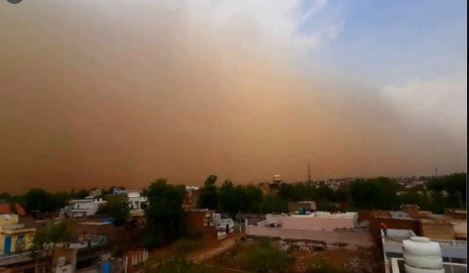The dust storm in Delhi last week and in Mumbai on Monday occurred due to western disturbance, easterly winds, and high temperatures. Geographical factors such as Mumbai‘s proximity to the Arabian Sea and neighbouring arid regions make it more prone to strong winds
The dust storm in Mumbai not only brought relief to its residents from the severe heat but killed nearly 14 and injured some 75 after a hoarding collapsed on them in Ghatkopar. Last week, a similar dust storm hit Delhi at night, killing two people and injuring 23. Both events occurred due to fierce external winds.
So, what exactly is a dust storm?
A dust storm is a wall of dust and debris that is often blown into an area by strong winds from thunderstorms. Dust storms kick up a lot of dust into the air. Scientists estimate that on average, about 44 billion pounds (20 teragrams) of dust are in Earth’s atmosphere at any one time.
A dust storm is caused by very strong winds — often produced by thunderstorms. In dry regions, the winds can pull dust from the ground up into the air, creating a dust storm.
An area’s geography and plant life allow winds to build up momentum, causing the winds to grow stronger and drive more dust into the atmosphere. For example, dust storms are common in regions that are flat and have few trees and plants.
As per a report by Down To Earth magazine, the formation of any storm is due to heating of the land. Usually, heating of 4-5 days is needed for convection to form which develops into a storm, said KJ Ramesh, former director-general of India Meteorological Department (IMD).
Once the storm forms, it is piloted by cold and dry “downdraft winds” and aided by gravity, Ramesh said as quoted by Down To Earth.
What Caused the Storm in Mumbai?
According to an expert quoted by Down To Earth, the storm formed around Igatpuri between Mumbai and Nashik seemed to have moved in a westerly direction but was “suddenly pushed in southwest direction towards Kalyan and Thane due to the prevailing winds”.
The expert quoted by Down To Earth also explained “the easterly winds were dominant over the normal westerly winds which flow in from the sea. The storm system expanded and intensified around Badlapur due to a merger with another storm which was not expected”.
Geographical factors such as Mumbai’s proximity to the Arabian Sea and neighbouring arid regions make it more prone to strong winds laden with sand and dust.
Also, Mumbai’s sweltering climate during the summer months makes it more pliable for dust storms. Intensified by soaring temperatures, the parched air sets the stage for a whirlwind of dust and debris.
Human activities such as deforestation and rapid urbanisation are also key factors behind Mumbai losing its greenery, leaving the soil to erosion.
Read More: Canada Imposes Rs 82 Lakh Penalty On Infosys For Alleged Underpayment Of Tax
SO, WHAT HAPPENED IN DELHI?
The Delhi Police received several distress calls about damaging buildings and power outages. With wind speeds of up to 77 km per hour recorded in certain parts of the city, a scientist at the India Meteorological Department (IMD) said the storm was a result of a western disturbance, easterly winds, and high temperatures that led to the formation of convective clouds.
Western disturbances are extratropical storms from the Mediterranean that cause winter rain in the northwestern subcontinent. The moisture from these storms is carried in the upper atmosphere and can lead a rain when lash with Himalayas.
The storm that occurred in Delhi last week has important implications for agriculture, particularly for the Rabi crops that rely on rains brought by western disturbances.
IS THERE A LINK BETWEEN DUST STORM AND CLIMATE CHANGE?
Data suggests that climate change can influence the frequency and intensity of dust storms. Also, climate change can also alter atmospheric circulation patterns, which may affect the movement of dust storms over large areas.
Climate change can also impact land degradation processes such as deforestation, overgrazing and unsustainable land management practices, increasing lose soil particles caused by erosion.
Scientific evidences and studies showed that the intensity of sandstorms is going to become more intense as the temperature increases further. It is indeed linked to climate change, as the UNESCAP (United Nations Economic and Social Commission for Asia and the Pacific) stated in its report on Sand and Dust Storms in Asia and the Pacific.
“As temperatures and drought occurrence increase, reduced soil moisture will greatly contribute towards increasing the intensity and frequency of sand and dust storms in South, South-West and Central Asia. This includes India in South Asia,” the UNESCAP report said.
IMPLICATIONS OF DUST STORMS ON HEALTH AND HOW TO ADDRESS THEM?
As per the World Meteorological Organisation, dust storms should be dealt with an integrated approach, which involves sustainable management, climate change mitigation and adaptation, early warning systems and international cooperation.
Dust storms can pose health problems. Individuals should seek refuge at home when a warning for the dust storm has been sounded. Windows and doors should be shut against infiltrating dust. Installing an air purifier can make the immediate surrounding cleaner.
A global scientific review published in March 2023 found how dust or sand storms affect respiratory and cardiovascular mortality. Dust emitted from the North Africa region reaches as far as the rest of Africa, Middle East, Europe, Asia, the Caribbean and the Americas, impacting air quality in those regions too.
Over 500 million people in India and more than 80% of the entire populations of Turkmenistan, Pakistan, Uzbekistan, Tajikistan and the Islamic Republic of Iran are exposed to medium and high levels of poor air quality due to sand and dust storms, stated the UNESCAP in a report released in 2021.
Increased concentrations of dust can adversely affect health and even lead to death, cautioned UNCCD in its report referring to WHO data.
Governments and international institutions should investigate into the precise cause of the dust storm, air quality, epidemic outbreak or crop damages.





































